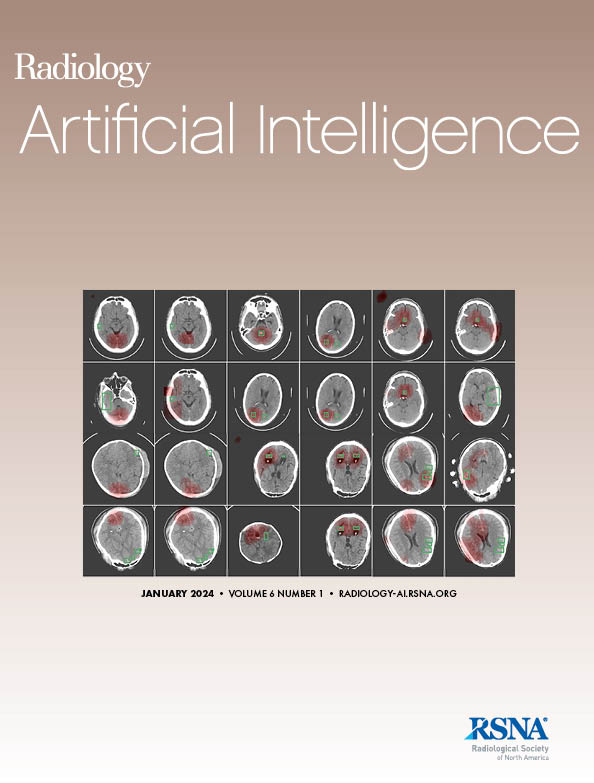Vishnu M Bashyam, Guray Erus, Yuhan Cui, Di Wu, Gyujoon Hwang, Alexander Getka, Ashish Singh, George Aidinis, Kyunglok Baik, Randa Melhem, Elizabeth Mamourian, Jimit Doshi, Ashwini Davison, Ilya M Nasrallah, Christos Davatzikos
求助PDF
{"title":"DLMUSE:使用深度学习在几秒钟内进行稳健的大脑分割。","authors":"Vishnu M Bashyam, Guray Erus, Yuhan Cui, Di Wu, Gyujoon Hwang, Alexander Getka, Ashish Singh, George Aidinis, Kyunglok Baik, Randa Melhem, Elizabeth Mamourian, Jimit Doshi, Ashwini Davison, Ilya M Nasrallah, Christos Davatzikos","doi":"10.1148/ryai.240299","DOIUrl":null,"url":null,"abstract":"<p><p>Purpose To introduce an open-source deep learning brain segmentation model for fully automated brain MRI segmentation, enabling rapid segmentation and facilitating large-scale neuroimaging research. Materials and Methods In this retrospective study, a deep learning model was developed using a diverse training dataset of 1900 MRI scans (ages 24-93 with a mean of 65 years (SD: 11.5 years) and 1007 females and 893 males) with reference labels generated using a multiatlas segmentation method with human supervision. The final model was validated using 71391 scans from 14 studies. Segmentation quality was assessed using Dice similarity and Pearson correlation coefficients with reference segmentations. Downstream predictive performance for brain age and Alzheimer's disease was evaluated by fitting machine learning models. Statistical significance was assessed using Mann-Whittney U and McNemar's tests. Results The DLMUSE model achieved high correlation (r = 0.93-0.95) and agreement (median Dice scores = 0.84-0.89) with reference segmentations across the testing dataset. Prediction of brain age using DLMUSE features achieved a mean absolute error of 5.08 years, similar to that of the reference method (5.15 years, <i>P</i> = .56). Classification of Alzheimer's disease using DLMUSE features achieved an accuracy of 89% and F1-score of 0.80, which were comparable to values achieved by the reference method (89% and 0.79, respectively). DLMUSE segmentation speed was over 10000 times faster than that of the reference method (3.5 seconds vs 14 hours). Conclusion DLMUSE enabled rapid brain MRI segmentation, with performance comparable to that of state-of-theart methods across diverse datasets. The resulting open-source tools and user-friendly web interface can facilitate large-scale neuroimaging research and wide utilization of advanced segmentation methods. ©RSNA, 2025.</p>","PeriodicalId":29787,"journal":{"name":"Radiology-Artificial Intelligence","volume":" ","pages":"e240299"},"PeriodicalIF":13.2000,"publicationDate":"2025-09-17","publicationTypes":"Journal Article","fieldsOfStudy":null,"isOpenAccess":false,"openAccessPdf":"","citationCount":"0","resultStr":"{\"title\":\"DLMUSE: Robust Brain Segmentation in Seconds Using Deep Learning.\",\"authors\":\"Vishnu M Bashyam, Guray Erus, Yuhan Cui, Di Wu, Gyujoon Hwang, Alexander Getka, Ashish Singh, George Aidinis, Kyunglok Baik, Randa Melhem, Elizabeth Mamourian, Jimit Doshi, Ashwini Davison, Ilya M Nasrallah, Christos Davatzikos\",\"doi\":\"10.1148/ryai.240299\",\"DOIUrl\":null,\"url\":null,\"abstract\":\"<p><p>Purpose To introduce an open-source deep learning brain segmentation model for fully automated brain MRI segmentation, enabling rapid segmentation and facilitating large-scale neuroimaging research. Materials and Methods In this retrospective study, a deep learning model was developed using a diverse training dataset of 1900 MRI scans (ages 24-93 with a mean of 65 years (SD: 11.5 years) and 1007 females and 893 males) with reference labels generated using a multiatlas segmentation method with human supervision. The final model was validated using 71391 scans from 14 studies. Segmentation quality was assessed using Dice similarity and Pearson correlation coefficients with reference segmentations. Downstream predictive performance for brain age and Alzheimer's disease was evaluated by fitting machine learning models. Statistical significance was assessed using Mann-Whittney U and McNemar's tests. Results The DLMUSE model achieved high correlation (r = 0.93-0.95) and agreement (median Dice scores = 0.84-0.89) with reference segmentations across the testing dataset. Prediction of brain age using DLMUSE features achieved a mean absolute error of 5.08 years, similar to that of the reference method (5.15 years, <i>P</i> = .56). Classification of Alzheimer's disease using DLMUSE features achieved an accuracy of 89% and F1-score of 0.80, which were comparable to values achieved by the reference method (89% and 0.79, respectively). DLMUSE segmentation speed was over 10000 times faster than that of the reference method (3.5 seconds vs 14 hours). Conclusion DLMUSE enabled rapid brain MRI segmentation, with performance comparable to that of state-of-theart methods across diverse datasets. The resulting open-source tools and user-friendly web interface can facilitate large-scale neuroimaging research and wide utilization of advanced segmentation methods. ©RSNA, 2025.</p>\",\"PeriodicalId\":29787,\"journal\":{\"name\":\"Radiology-Artificial Intelligence\",\"volume\":\" \",\"pages\":\"e240299\"},\"PeriodicalIF\":13.2000,\"publicationDate\":\"2025-09-17\",\"publicationTypes\":\"Journal Article\",\"fieldsOfStudy\":null,\"isOpenAccess\":false,\"openAccessPdf\":\"\",\"citationCount\":\"0\",\"resultStr\":null,\"platform\":\"Semanticscholar\",\"paperid\":null,\"PeriodicalName\":\"Radiology-Artificial Intelligence\",\"FirstCategoryId\":\"1085\",\"ListUrlMain\":\"https://doi.org/10.1148/ryai.240299\",\"RegionNum\":0,\"RegionCategory\":null,\"ArticlePicture\":[],\"TitleCN\":null,\"AbstractTextCN\":null,\"PMCID\":null,\"EPubDate\":\"\",\"PubModel\":\"\",\"JCR\":\"Q1\",\"JCRName\":\"COMPUTER SCIENCE, ARTIFICIAL INTELLIGENCE\",\"Score\":null,\"Total\":0}","platform":"Semanticscholar","paperid":null,"PeriodicalName":"Radiology-Artificial Intelligence","FirstCategoryId":"1085","ListUrlMain":"https://doi.org/10.1148/ryai.240299","RegionNum":0,"RegionCategory":null,"ArticlePicture":[],"TitleCN":null,"AbstractTextCN":null,"PMCID":null,"EPubDate":"","PubModel":"","JCR":"Q1","JCRName":"COMPUTER SCIENCE, ARTIFICIAL INTELLIGENCE","Score":null,"Total":0}
引用次数: 0
引用
批量引用

 求助内容:
求助内容: 应助结果提醒方式:
应助结果提醒方式:


